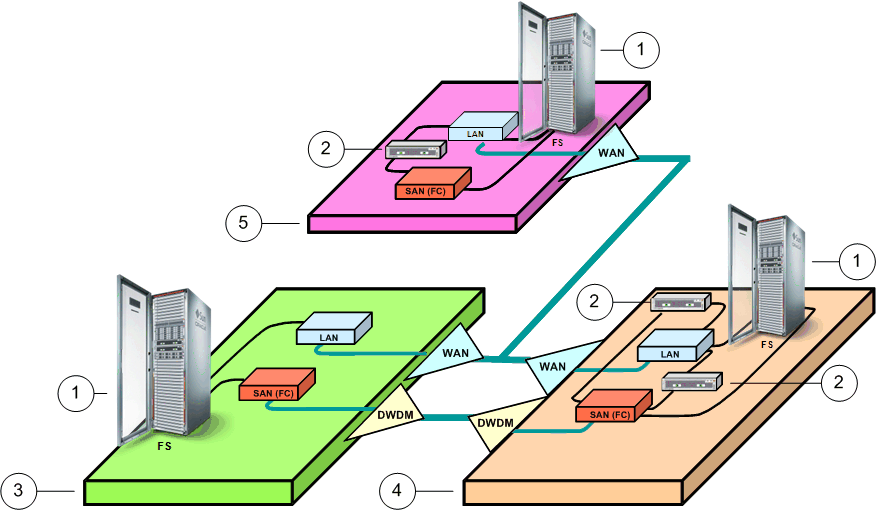Multi-hop replication provides synchronous replication of a source LUN to a target LUN, and a second asynchronous replication of that target LUN to an additional target LUN.
Multi-hop replication requires both a synchronous and an asynchronous capacity-based license. The first synchronous hop of replication occurs between two Oracle FS Systems that are connected to the same SAN fabrics either at the same physical location, or between sites where the SAN fabrics are extended using dense wavelength division multiplexing (DWDM). The second hop of replication is asynchronous from the target Oracle FS System of the first synchronous hop to a remote location connected using the WAN.
-
Multi-hop replicates data from the source LUN to one target LUN. Then, this secondary target LUN is replicated to a third LUN.
-
One‑to‑many replicates data from the source LUN at the primary site to multiple targets at multiple locations.
For example, a multi-hop replication configuration consists of an Oracle MaxRep Replication Engine and two Oracle FS Systems that are set up in a synchronous replication relationship at the primary site. In addition, another Replication Engine and Oracle FS System at the secondary site are set up in an asynchronous replication relationship with the secondary Oracle FS System at the primary site.
When data from the application host is written to the source LUN at the primary site, the Replication Engine replicates any data changes to the secondary LUN on another Oracle FS System at the primary site. This is the synchronous hop of the multi-hop replication.
The target LUN from the synchronous replication acts as a source LUN to the asynchronous hop of the multi-hop solution. As writes are received to the target LUN of the synchronous replication, a copy of its data and metadata is sent to the Oracle FS System located at the secondary site.
Figure 1: Multi-hop replication configuration

Release 3.0 of Oracle MaxRep for SAN requires two separate MaxRep Replication Engine configurations for multi-hop replication. A minimum of three MaxRep Replication Engines are required for a multi-hop configuration.
For example, a multi-hop solution can contain three Oracle Flash Storage Systems or three Pillar Axiom 600 systems dispersed over the three physical sites. This multi-hop replication topology would require the minimum amount of MaxRep R3 Replication Engines.
The first MaxRep R3 Replication Engine would replicate data synchronously between a source and target Oracle FS1 Flash Storage System or Pillar Axiom 600 system that are located at separate physical sites, if connected over dark fiber or DWDM.
The second and third MaxRep R3 Replication Engines would then replicate data asynchronously from the target Oracle FS1 Flash Storage System or Pillar Axiom 600 system in the first configuration to a third Oracle FS1 Flash Storage System or Pillar Axiom 600 system located at a third site.
This is accomplished by configuring the second MaxRep R3 Replication Engine in the second configuration to use the target Oracle FS1 Flash Storage System or Pillar Axiom 600 system from the first configuration as a source. The data would then be replicated asynchronously to a third site containing a target Oracle FS1 Flash Storage System or a target Pillar Axiom 600 system.
